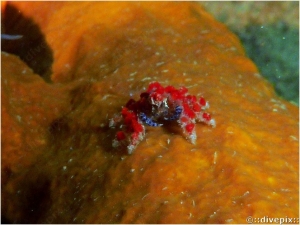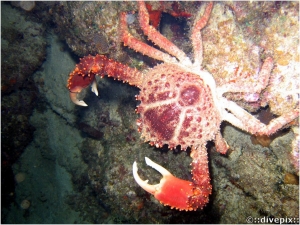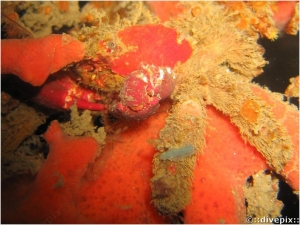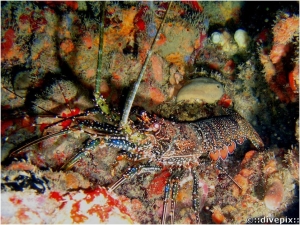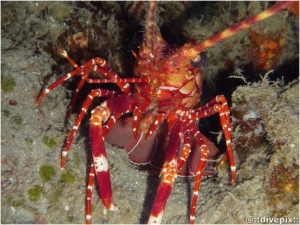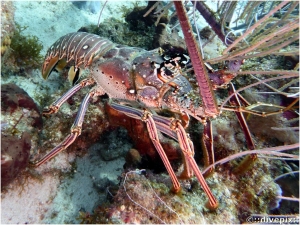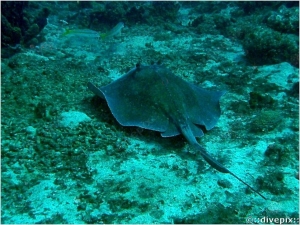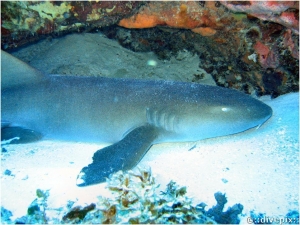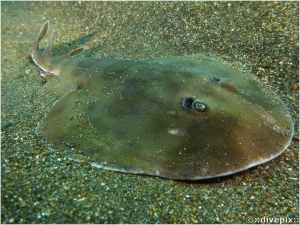




Eric H. Biass
jeudi, 17 janvier 2013 22:49
Cryptic Teardrop Crab
| Aspect: | Very small (2cm max) crab covered in bright red "pompons" which are in fact live sponges, which puts it in the category of "decorator crabs". Hairy main legs, while claws are purple with tiny black dots. |
| Population: | Common, but usually only visible at night. |
| Notable feature: | Extremely difficult to spot. |
| Environment: | Hides under algae or in crevices. |
| Behaviour: | Relatively unscared. |
Publié dans
Crabes
Tags:
jeudi, 17 janvier 2013 22:21
Channel Clinging Crab
| Aspect: | Red-marroon carapace and legs. Carapace is covered in warty bumps, legs covered in spiny nodules. |
| Population: | Common, very visible during night dives. |
| Notable feature: | Large claws distinguishes it from Hairy Clinging Crab (q.v.) |
| Environment: | Around coral boulders and rocks under which it hides during the day, but can also live on ship wrecks. |
| Behaviour: | Will stay quiet if not approached too aggressively. |
Publié dans
Crabes
Tags:
mercredi, 19 décembre 2012 01:06
Slipper Lobster - Moult
Publié dans
Langoustes
Tags:
mercredi, 19 décembre 2012 00:33
Spotted Spiny Lobster
| Aspect: | Dark brown to black carapace with purple shades, entirely covered with numerous small white dots, except for the end of the legs that are bright orange with darker longitudinal stripes. The tail has the same bright orange colour, but its edge is adorned with a darker line. |
| Population: | Common, especially at night, unlike Caribbean Spiny Lobster (q.v.), which can often be seen during day time as well. The two main antennae are dark green. |
| Notable feature: | It is the second largest lobster in this region after the Caribbean Spiny Lobster. |
| Environment: | Lives around rocks and coral boulders that offer sheltering caves, which it enters backwards. When in danger, it also swims away backwards by violently kicking its fully fanned out tail forwards. |
| Behaviour: | Wary, but can be approached slowly. |
Publié dans
Langoustes
Tags:
dimanche, 16 décembre 2012 16:07
Caribbean Spiny Lobster
| Aspect: | Dark brown to black head carapace and abdomen top, with the head carapace gradually turning orange/red and then tan on the sides. Each element of the abdomen carapace carries a line of between four and six white spots, with the larger spots on the sides. Legs are blue or purple. The swimmeretes (the shield-shaped plates) on the sides of the abdomen) have the same colour scheme as the tail, i.e yellow or orange with a black bar. |
| Population: | Common, can be seen day and night, with a preference for night. Entire families (of more than ten individuals) can often be encountered hiding under a rock ledge, or even under the side of a shipwreck keel. Because Ilets Pigeon are a protected area, some lobsters can reach humongous proportions. |
| Notable feature: | It is the largest lobster in this region, followed by the Spotted Spiny Lobster (q.v.). Large black eyes are located atop porminent stalks themselves protected by "horns". The antennae are purple. |
| Environment: | Lives around rocks and coral boulders that offer sheltering caves, which it enters backwards. When in danger, it also swims away backwards by violently thrusting its fully fanned out tail forwards. |
| Behaviour: | Wary, but can be easily be approached. |
Publié dans
Langoustes
Tags:
vendredi, 14 décembre 2012 23:58
Southern Stingray
| Aspect: | Light to grey/olive upper body, lighter coloured underbelly, whip-thin tail end. |
| Population: | Common. |
| Notable feature: | Diamond-shaped forebody, tail base carries several venomous darts. |
| Environment: | Sandy, weedy sea bottoms. |
| Behaviour: | Unscared, can be approached, but will swim away if approached too closely. |
Publié dans
Raies
Tags:
vendredi, 14 décembre 2012 23:49
Nurse Shark
| Aspect: | Grey, fatish body, relatively large rounded head, small mouth and eyes. |
| Population: | Occasional, on Jardin Japonais site, near Ilêts Pigeon. |
| Notable feature: | Two side-barbels under the snout. |
| Environment: | Rock overhangs in which it sleeps during the day. |
| Behaviour: | Unscared, can be approached quite closely, but quietly. |
Publié dans
Requins
Tags:
vendredi, 14 décembre 2012 23:35
Lesser Electric Ray
| Aspect: | Brown, almost disc-shaped, upper body, lighter coloured belly. |
| Population: | Common. |
| Notable feature: | Short, triple-finned tail (two of these actually are the dorsal fins). |
| Environment: | Sandy bottom, from less than one metre depths to over 30. |
| Behaviour: | Relatively unscared, can be approached. Lands over smaller fish and sends a 35-Volt jolt to stun its prey. |
Publié dans
Raies
Tags:



